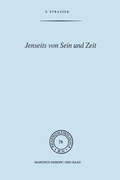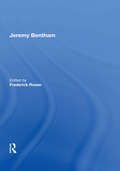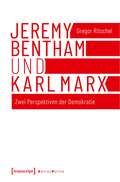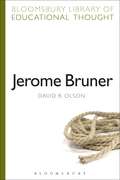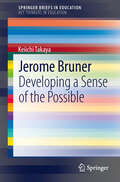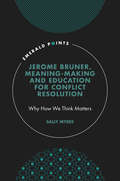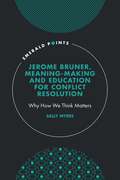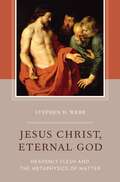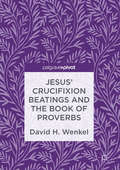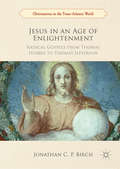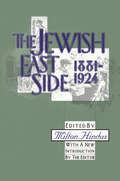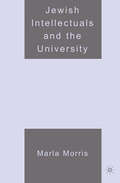- Table View
- List View
Jenseits von Sein und Zeit: Eine Einführung in Emmanuel Levinas’ Philosophie (Phaenomenologica #78)
by Stephan StrasserJeremy Bentham
by Frederick RosenJeremy Bentham's (1748-1832) writings in social and political thought were both theoretical and practical. As a theorist, he made important contributions to the modern understanding of the principle of utility, to ideas of sovereignty, liberty and justice and to the importance of radical reform in a representative democracy. As a reformer, his ideas regarding constitutionalism, revolution, individual liberty and the extent of government have not only played an important role in eighteenth and nineteenth century debates but also, together with his theoretical work, remain relevant to similar debates today. This volume includes essays from leading Bentham scholars plus an introduction, surveying recent scholarship, by Frederick Rosen, formerly Director of the Bentham Project and Professor Emeritus of the History of Political Thought, University College London.
Jeremy Bentham
by Frederick RosenJeremy Bentham's (1748-1832) writings in social and political thought were both theoretical and practical. As a theorist, he made important contributions to the modern understanding of the principle of utility, to ideas of sovereignty, liberty and justice and to the importance of radical reform in a representative democracy. As a reformer, his ideas regarding constitutionalism, revolution, individual liberty and the extent of government have not only played an important role in eighteenth and nineteenth century debates but also, together with his theoretical work, remain relevant to similar debates today. This volume includes essays from leading Bentham scholars plus an introduction, surveying recent scholarship, by Frederick Rosen, formerly Director of the Bentham Project and Professor Emeritus of the History of Political Thought, University College London.
Jeremy Bentham und Karl Marx: Zwei Perspektiven der Demokratie (Edition Politik #65)
by Gregor RitschelKarl Marx' (1818-1883) Polemiken gegen das »Genie bürgerlicher Dummheit« Jeremy Bentham (1748-1832) sind weithin bekannt. Gegenstand seiner strategischen Attacken war jedoch weniger die Person Bentham selbst, sondern vielmehr die bürgerliche Marktgläubigkeit der Zeit, zu dessen Stammvater er Bentham als »Urphilister« stilisierte. Jenseits seiner Polemik kam Marx aber tatsächlich zu einer ambivalenten Einschätzung von Benthams Utilitarismus. Beim systematischen Vergleich beider Autoren und deren Kritik an anti-demokratischen Zuständen deckt Gregor Ritschel viele gemeinsame Themen und Gedanken auf, die zusammengenommen eine neue, komplementäre Lesart zulassen.
Jerome Bruner: The Cognitive Revolution In Educational Theory (Bloomsbury Library of Educational Thought)
by David R. OlsonJerome Bruner is the vanguard of “the cognitive revolution” in psychology and the predominant spokesman for the role of culture and education in the making of the modern mind. In this text Olson encourages the reader to think about children as Bruner did, not as bundles of traits and dispositions to be diagnosed and remediated, but as thoughtful, keenly interested, agentive persons who are willing and indeed able to play an important role in their own learning and development.Through the unique approach of combining commentary and conversation with Bruner, the author provides an insight into what it is like to engage with one of the intellectual masters of our time and highlights the relevance and importance of his contribution to educational thinking today.
Jerome Bruner: The Cognitive Revolution In Educational Theory (Bloomsbury Library of Educational Thought)
by David R. Olson Richard BaileyJerome Bruner is the vanguard of "the cognitive revolution†? in psychology and the predominant spokesman for the role of culture and education in the making of the modern mind. In this text Olson encourages the reader to think about children as Bruner did, not as bundles of traits and dispositions to be diagnosed and remediated, but as thoughtful, keenly interested, agentive persons who are willing and indeed able to play an important role in their own learning and development.Through the unique approach of combining commentary and conversation with Bruner, the author provides an insight into what it is like to engage with one of the intellectual masters of our time and highlights the relevance and importance of his contribution to educational thinking today.
Jerome Bruner: Developing a Sense of the Possible (SpringerBriefs in Education)
by Keiichi TakayaJerome S. Bruner (1915- ) is one of the best known and most influential psychologists of the twentieth century. He has made significant contributions to cognitive psychology and educational theory. This book presents a brief introduction to Jerome Bruner’s educational ideas and details their influences on our educational discourse and practice. It examines Bruner’s ideas in the context of some key educational issues in the United States since the early twentieth century. Jerome Bruner: Developing a Sense of the Possible will be an inspiration, and vital call to action, to readers looking to better understand today’s instructional and curriculum theories. It will help readers gain invaluable insight into the ways teaching and schools can be improved in the future.
Jerome Bruner, Meaning-Making and Education for Conflict Resolution: Why How We Think Matters (Emerald Points)
by Sally MyersThe way we think about things matters just as much as what we think about things.This timely text investigates the work of educational philosopher and psychologist Jerome Bruner through the areas of knowledge representation, meaning-making, education and dispute. What people represent to others might not always be what they actually think. However, accepting this limitation, the aim of this book is to offer a means of examining representations about a given subject and an understanding of how those representations might change over time in response to learning, crisis, and encounter with 'other'.Myers offers an educational intervention that invites development of representations in response to difference. Presenting a new framework for examining controversy between worldviews and a method for creating space for difference, the book brings this into dialogue with education and research, conflict resolution and religion. This framework maps representations and proposes a method of engaging the psychological processes involved in changing representations.An excellent resource of interest to researchers, professionals and postgraduate students alike in education, sociology and philosophy related disciplines.
Jerome Bruner, Meaning-Making and Education for Conflict Resolution: Why How We Think Matters (Emerald Points)
by Sally MyersThe way we think about things matters just as much as what we think about things.This timely text investigates the work of educational philosopher and psychologist Jerome Bruner through the areas of knowledge representation, meaning-making, education and dispute. What people represent to others might not always be what they actually think. However, accepting this limitation, the aim of this book is to offer a means of examining representations about a given subject and an understanding of how those representations might change over time in response to learning, crisis, and encounter with 'other'.Myers offers an educational intervention that invites development of representations in response to difference. Presenting a new framework for examining controversy between worldviews and a method for creating space for difference, the book brings this into dialogue with education and research, conflict resolution and religion. This framework maps representations and proposes a method of engaging the psychological processes involved in changing representations.An excellent resource of interest to researchers, professionals and postgraduate students alike in education, sociology and philosophy related disciplines.
Jesus Christ, Eternal God: Heavenly Flesh and the Metaphysics of Matter
by Stephen H. WebbIn this groundbreaking study, Stephen H. Webb offers a new theological understanding of the material and spiritual: that, far from being contradictory, they unite in the very stuff of the eternal Jesus Christ. Accepting matter as a perfection (or predicate) of the divine requires a rethinking of the immateriality of God, the doctrine of creation out of nothing, the Chalcedonian formula of the person of Christ, and the analogical nature of religious language. It also requires a careful reconsideration of Augustine's appropriation of the Neo-Platonic understanding of divine incorporeality as well as Origen's rejection of anthropomorphism. Webb locates his position in contrast to evolutionary theories of emergent materialism and the popular idea that the world is God's body. He draws on a little known theological position known as the ''heavenly flesh'' Christology, investigates the many misunderstandings of its origins and relation to the Monophysite movement, and supplements it with retrievals of Duns Scotus, Caspar Scwenckfeld and Eastern Orthodox reflections on the transfiguration. Also included in Webb's study are discussions of classical figures like Barth and Aquinas as well as more recent theological proposals from Bruce McCormack, David Hart, and Colin Gunton. Perhaps most provocatively, the book argues that Mormonism provides the most challenging, urgent, and potentially rewarding source for metaphysical renewal today. Webb's concept of Christian materialism challenges traditional Christian common sense, and aims to show the way to a more metaphysically sound orthodoxy.
Jesus Christ, Eternal God: Heavenly Flesh and the Metaphysics of Matter
by Stephen H. WebbIn this groundbreaking study, Stephen H. Webb offers a new theological understanding of the material and spiritual: that, far from being contradictory, they unite in the very stuff of the eternal Jesus Christ. Accepting matter as a perfection (or predicate) of the divine requires a rethinking of the immateriality of God, the doctrine of creation out of nothing, the Chalcedonian formula of the person of Christ, and the analogical nature of religious language. It also requires a careful reconsideration of Augustine's appropriation of the Neo-Platonic understanding of divine incorporeality as well as Origen's rejection of anthropomorphism. Webb locates his position in contrast to evolutionary theories of emergent materialism and the popular idea that the world is God's body. He draws on a little known theological position known as the ''heavenly flesh'' Christology, investigates the many misunderstandings of its origins and relation to the Monophysite movement, and supplements it with retrievals of Duns Scotus, Caspar Scwenckfeld and Eastern Orthodox reflections on the transfiguration. Also included in Webb's study are discussions of classical figures like Barth and Aquinas as well as more recent theological proposals from Bruce McCormack, David Hart, and Colin Gunton. Perhaps most provocatively, the book argues that Mormonism provides the most challenging, urgent, and potentially rewarding source for metaphysical renewal today. Webb's concept of Christian materialism challenges traditional Christian common sense, and aims to show the way to a more metaphysically sound orthodoxy.
Jesus' Crucifixion Beatings and the Book of Proverbs
by David H. WenkelThis study takes a Christian perspective on the entire Bible, rather than simply the New Testament. David Wenkel asks: Why did Jesus have to be beaten before his death on the cross? Christian theology has largely focused on Jesus’ death but has given relatively little attention to his sufferings. Wenkel’s answer contextualizes Jesus’ crucifixion sufferings as informed by the language of Proverbs. He explains that Jesus’ sufferings demonstrate the wisdom of God’s plan to provide a substitute for foolish sinners. Jesus was beaten as a fool – even though he was no fool, in order to fulfill God’s loving plan of salvation. This analysis is then placed within the larger storyline of the whole bible – from the Garden of Eden to the story of Israel and beyond.
Jesus' Crucifixion Beatings and the Book of Proverbs
by David H. WenkelThis study takes a Christian perspective on the entire Bible, rather than simply the New Testament. David Wenkel asks: Why did Jesus have to be beaten before his death on the cross? Christian theology has largely focused on Jesus’ death but has given relatively little attention to his sufferings. Wenkel’s answer contextualizes Jesus’ crucifixion sufferings as informed by the language of Proverbs. He explains that Jesus’ sufferings demonstrate the wisdom of God’s plan to provide a substitute for foolish sinners. Jesus was beaten as a fool – even though he was no fool, in order to fulfill God’s loving plan of salvation. This analysis is then placed within the larger storyline of the whole bible – from the Garden of Eden to the story of Israel and beyond.
Jesus in an Age of Enlightenment: Radical Gospels from Thomas Hobbes to Thomas Jefferson (Christianities in the Trans-Atlantic World)
by Jonathan C. BirchThis book explores the religious concerns of Enlightenment thinkers from Thomas Hobbes to Thomas Jefferson. Using an innovative method, the study illuminates the intellectual history of the age through interpretations of Jesus between c.1750 and c.1826. The book demonstrates the persistence of theology in modern philosophy and the projects of social reform and amelioration associated with the Enlightenment. At the core of many of these projects was a robust moral-theological realism, sometimes manifest in a natural law ethic, but always associated with Jesus and a commitment to the sovereign goodness of God. This ethical orientation in Enlightenment discourse is found in a range of different metaphysical and political identities (dualist and monist; progressive and radical) which intersect with earlier ‘heretical’ tendencies in Christian thought (Arianism, Pelagianism, and Marcionism). This intellectual matrix helped to produce the discourses of irenic toleration which are a legacy of the Enlightenment at its best.
Jesus überlistet Darwin: Mit einem Vorwort von Thomas Grunwald (TRACE Transmission in Rhetorics, Arts and Cultural Evolution)
by Heiner MühlmannDas Werk bietet eine kompakte, leicht lesbare und verständliche Einführung in die Darwinsche Theorie der Kulturevolution. Dabei wird Kultur nicht als Prozess eines genetisch-biologischen Determinismus beschrieben, sondern als eigengesetzliche Evolution. Für eine spannende Lektüre sorgt das kulturelle Fallbeispiel "Jesus", das den Konflikt Religion/Evolutionstheorie aufgreift. Das Werk ist didaktisch hervorragend aufbereitet, indem Sprache durch Illustrationen und Diagramme optimal ergänzt wird.
Jet Lag (Object Lessons)
by Christopher J. LeeObject Lessons is a series of short, beautifully designed books about the hidden lives of ordinary things. Jet lag is a momentary condition resulting from the human body and its inner clock being pitched against the time-leaping effects of modern aviation. But more than that, it is a situation that explains time, technology, and the human body. Jet lag epitomizes the accelerated world we live in. It makes the speed and discomfort of globalization tangible on a personal level. Tracing physiological, temporal, technological, and cultural meanings, Christopher J. Lee's Jet Lag ponders our intrinsic human limits in the face of modern innovation, revealing the latent costs of global cosmopolitanism today.Object Lessons is published in partnership with an essay series in The Atlantic.
Jet Lag (Object Lessons)
by Christopher J. LeeObject Lessons is a series of short, beautifully designed books about the hidden lives of ordinary things. Jet lag is a momentary condition resulting from the human body and its inner clock being pitched against the time-leaping effects of modern aviation. But more than that, it is a situation that explains time, technology, and the human body. Jet lag epitomizes the accelerated world we live in. It makes the speed and discomfort of globalization tangible on a personal level. Tracing physiological, temporal, technological, and cultural meanings, Christopher J. Lee's Jet Lag ponders our intrinsic human limits in the face of modern innovation, revealing the latent costs of global cosmopolitanism today.Object Lessons is published in partnership with an essay series in The Atlantic.
Jewish Antifascism and the False Promise of Settler Colonialism
by Max KaiserThis book takes a timely look at histories of radical Jewish movements, their modes of Holocaust memorialisation, and their relationships with broader anti-colonial and anti-racist struggles. Its primary focus is Australia, where Jewish antifascism was a major political and cultural force in Jewish communities in the 1940s and early 1950s. This cultural and intellectual history of Jewish antifascism utilises a transnational lens to provide an exploration of a Jewish antifascist ideology that took hold in the middle of the twentieth century across Jewish communities worldwide. It argues that Jewish antifascism offered an alternate path for Jewish politics that was foreclosed by mutually reinforcing ideologies of settler colonialism, both in Palestine and Australia.
Jewish Christians and Christian Jews: From the Renaissance to the Enlightenment (International Archives of the History of Ideas Archives internationales d'histoire des idées #138)
by Gordon M. Weiner Richard H. PopkinThe appearance of religious toleration combined with the intensification of the search for theological truth led to a unique phenomenon in early modern Europe: Jewish Christians and Christian Jews. These essays will demonstrate that the cross-fertilization of these two religions, which for so long had a tradition of hostility towards each other, not only affected developments within the two groups but in many ways foreshadowed the emergence of the Enlightenment and the evolution of modern religious freedom.
Jewish Cryptotheologies of Late Modernity: Philosophical Marranos (Routledge Jewish Studies Series)
by Agata Bielik-RobsonThis book aims to interpret ‘Jewish Philosophy’ in terms of the Marrano phenomenon: as a conscious clinamen of philosophical forms used in order to convey a ‘secret message’ which cannot find an open articulation. The Marrano phenomenon is employed here, in the domain of modern philosophical thought, where an analogous tendency can be seen: the clash of an open idiom and a secret meaning, which transforms both the medium and the message. Focussing on key figures of late modern, twentieth century Jewish thought; Hermann Cohen, Gershom Scholem, Walter Benjamin, Franz Rosenzweig, Theodor Adorno, Ernst Bloch, Jacob Taubes, Emmanuel Levinas and Jacques Derrida, this book demonstrates how their respective manners of conceptualization swerve from the philosophical mainstream along the Marrano ‘secret curve.’ Analysing their unique contribution to the ‘unfinished project of modernity,’ including issues of the future of the Enlightenment, modern nihilism and post-secular negotiation with religious heritage, this book will be essential reading for students and researchers with an interest in Jewish Studies and Philosophy.
Jewish Cryptotheologies of Late Modernity: Philosophical Marranos (Routledge Jewish Studies Series)
by Agata Bielik-RobsonThis book aims to interpret ‘Jewish Philosophy’ in terms of the Marrano phenomenon: as a conscious clinamen of philosophical forms used in order to convey a ‘secret message’ which cannot find an open articulation. The Marrano phenomenon is employed here, in the domain of modern philosophical thought, where an analogous tendency can be seen: the clash of an open idiom and a secret meaning, which transforms both the medium and the message. Focussing on key figures of late modern, twentieth century Jewish thought; Hermann Cohen, Gershom Scholem, Walter Benjamin, Franz Rosenzweig, Theodor Adorno, Ernst Bloch, Jacob Taubes, Emmanuel Levinas and Jacques Derrida, this book demonstrates how their respective manners of conceptualization swerve from the philosophical mainstream along the Marrano ‘secret curve.’ Analysing their unique contribution to the ‘unfinished project of modernity,’ including issues of the future of the Enlightenment, modern nihilism and post-secular negotiation with religious heritage, this book will be essential reading for students and researchers with an interest in Jewish Studies and Philosophy.
The Jewish East Side: 1881-1924 (The Library of Conservative Thought)
by Milton HindusThis book, originally published as The Old East Side, is a collection of literature and documents ranging from the autobiography of the sculptor Jacob Epstein and the novels of Abraham Cahan to the reporting of William Dean Howells and the fictional reconstruction of a vanished world by Henry Roth. The world is that of the old shtetl transplanted to a new, growing country, where "the ghetto" (in the years 1881-1924) was an unstable mixture of nostalgic elements and the pressures of American economic and social reality.The productivity, both intellectual and material, of the section of New York known as the East Side during those forty years around the turn of the twentieth century has become a legend among many Jews in this country and deserves to become better known to many more of other ethnic origins. The lower East Side was paradoxically a wilderness to be traversed and a portion of that "promised land" which had been glimpsed with so much hope from afar. To wonderfully talented and observant children, like Jacob Epstein, the streets there in the 1880s were as filled with excitement as those of the Arabian Nights. To serious philosophic young men like Morris Raphael Cohen, they were as challenging as the marketplace of Athens had once been to Socrates to achieve intellectual enlightenment and the improvement of the social order.The conditions of abominable crowding and poverty described in the sociological tracts of Jacob Riis, Lillian Wald, and others are better known perhaps to the average reader than the accounts of such pleasures as the dancing schools, the Yiddish theaters, the cafes, the lectures, the literary ferment and activities, described in the pages of Abraham Cahan and Hutchins Hapgood. But all the views presented in The Jewish East Side, both dark and bright, are recognizably parts of the same picture. This book will be of value to sociologists, historians, researchers specializing in Judaic studies, and students of literature.
The Jewish East Side: 1881-1924 (The Library of Conservative Thought)
by Milton HindusThis book, originally published as The Old East Side, is a collection of literature and documents ranging from the autobiography of the sculptor Jacob Epstein and the novels of Abraham Cahan to the reporting of William Dean Howells and the fictional reconstruction of a vanished world by Henry Roth. The world is that of the old shtetl transplanted to a new, growing country, where "the ghetto" (in the years 1881-1924) was an unstable mixture of nostalgic elements and the pressures of American economic and social reality.The productivity, both intellectual and material, of the section of New York known as the East Side during those forty years around the turn of the twentieth century has become a legend among many Jews in this country and deserves to become better known to many more of other ethnic origins. The lower East Side was paradoxically a wilderness to be traversed and a portion of that "promised land" which had been glimpsed with so much hope from afar. To wonderfully talented and observant children, like Jacob Epstein, the streets there in the 1880s were as filled with excitement as those of the Arabian Nights. To serious philosophic young men like Morris Raphael Cohen, they were as challenging as the marketplace of Athens had once been to Socrates to achieve intellectual enlightenment and the improvement of the social order.The conditions of abominable crowding and poverty described in the sociological tracts of Jacob Riis, Lillian Wald, and others are better known perhaps to the average reader than the accounts of such pleasures as the dancing schools, the Yiddish theaters, the cafes, the lectures, the literary ferment and activities, described in the pages of Abraham Cahan and Hutchins Hapgood. But all the views presented in The Jewish East Side, both dark and bright, are recognizably parts of the same picture. This book will be of value to sociologists, historians, researchers specializing in Judaic studies, and students of literature.
Jewish Intellectuals and the University
by M. MorrisMarla Morris explores Jewish intellectuals in society and in the university using psychoanalytic theory. Morris examines Otherness as experienced by Jewish intellectuals who grapple with anti-Semitism within the halls of academia. She claims that academia breeds uncertainty and chaos.
